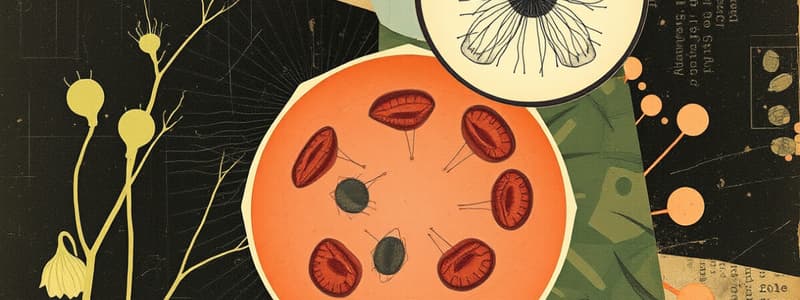Podcast
Questions and Answers
Which statement is TRUE regarding each specific level of organization?
Which statement is TRUE regarding each specific level of organization?
- A living tissue is made from a group of cells with a similar structure and function, which all work together to do a particular job.
- An organ system is made from a group of different organs, which all work together to do a particular job.
- Cells are the smallest structural units of living matter and compose all living things. (correct)
- An organ is made from a group of different tissues, which all work together to do a particular job.
Which groups/types of tissues do not belong to the same group?
Which groups/types of tissues do not belong to the same group?
- Ground meristem, procambium, and procambium (correct)
- Collenchyma, parenchyma, and sclerenchyma
- Phloem and xylem
- Embryonic, epidermis and periderm
What are apical meristematic tissues? They _________________________.
What are apical meristematic tissues? They _________________________.
are regions of cells capable of division and growth in the root and shoot tips in plants.
Which simple non-meristematic tissues are the most common cell types found in highly developed plants?
Which simple non-meristematic tissues are the most common cell types found in highly developed plants?
Which plant tissues are also regarded as mature or differentiated tissues?
Which plant tissues are also regarded as mature or differentiated tissues?
Which plant tissues transport water and dissolved substances from the roots to the stems and leaves?
Which plant tissues transport water and dissolved substances from the roots to the stems and leaves?
Which plant tissues are responsible for the distribution of food from the leaves to all parts of a plant?
Which plant tissues are responsible for the distribution of food from the leaves to all parts of a plant?
What are the major types of tissues found in multicellular animals?
What are the major types of tissues found in multicellular animals?
Which tissues cover the outermost part of multicellular animals?
Which tissues cover the outermost part of multicellular animals?
Which tissues are responsible for the reception and conduction of impulses in our body?
Which tissues are responsible for the reception and conduction of impulses in our body?
Which type of involuntary muscle tissue is found in the human heart?
Which type of involuntary muscle tissue is found in the human heart?
Which type of neuron links the sensory and motor neurons?
Which type of neuron links the sensory and motor neurons?
Why are connective tissues very important to multicellular animals? They __________________________.
Why are connective tissues very important to multicellular animals? They __________________________.
Flashcards
Plant Tissue Types
Plant Tissue Types
Plant tissues include types like collenchyma, parenchyma, and sclerenchyma for support and storage, and meristematic tissues for growth.
Apical Meristems
Apical Meristems
Plant growth regions at the tips of roots and shoots capable of cell division, leading to primary plant body growth.
Parenchyma Cells
Parenchyma Cells
Plant cells involved in photosynthesis, respiration, and protein synthesis.
Xylem Function
Xylem Function
Signup and view all the flashcards
Phloem Function
Phloem Function
Signup and view all the flashcards
Animal Tissue Types
Animal Tissue Types
Signup and view all the flashcards
Epithelial Tissue
Epithelial Tissue
Signup and view all the flashcards
Nervous Tissue Function
Nervous Tissue Function
Signup and view all the flashcards
Cardiac Muscle
Cardiac Muscle
Signup and view all the flashcards
Muscle Tissue Types
Muscle Tissue Types
Signup and view all the flashcards
Connective Tissue Role
Connective Tissue Role
Signup and view all the flashcards
Motor Neuron Function
Motor Neuron Function
Signup and view all the flashcards
Organ System
Organ System
Signup and view all the flashcards
Study Notes
Objectives of the Lesson
- Identify various cell types in plant and animal tissues.
- Classify these cells and describe their functions.
- Understand how cells, tissues, organs, and organ systems work together to sustain life.
Levels of Organization
- An organ consists of multiple tissues working collaboratively for a specific function.
- An organ system comprises different organs that perform related functions.
- Tissues are made up of similar cells that work together.
- Cells are the fundamental units of life, forming all living organisms.
Plant Tissues
- Types of Tissues:
- Collenchyma, parenchyma, sclerenchyma (support and storage).
- Meristematic tissues (apical, ground, procambium) for growth.
- Apical Meristems:
- Regions capable of cell division and growth at root and shoot tips.
- Contribute to the primary plant body and root/shoot extensions.
- Non-Meristematic Tissues:
- Parenchyma is involved in photosynthesis, respiration, and protein synthesis.
Transportation Tissues in Plants
- Xylem:
- Transports water and dissolved minerals from roots to stems and leaves.
- Phloem:
- Distributes food made in leaves to all plant parts.
Types of Tissues in Multicellular Animals
- Major Types:
- Connective, epithelial, muscular, and nervous tissues.
- Epithelial Tissues:
- Cover external and internal surfaces, including the digestive and respiratory tracts.
- Nervous Tissues:
- Responsible for receiving and transmitting impulses throughout the body.
Muscle Tissues
- Cardiac Muscle:
- Involuntary muscle found exclusively in the heart.
- Types of Muscle Tissue:
- Includes cardiac, skeletal, and smooth (visceral) muscles.
Importance of Connective Tissues
- Connective tissues bind and support different body parts.
- They serve as a packing material and help in excretion and secretion.
- Provide structural support and strength to bodily structures.
Nervous Tissues Functions
- Motor neurons transmit signals away from the central nervous system to effectors.
Studying That Suits You
Use AI to generate personalized quizzes and flashcards to suit your learning preferences.




